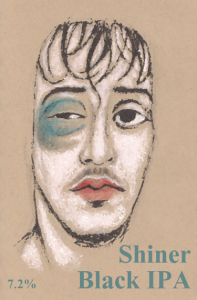Wayne Johnston
New Member
- Joined
- Nov 25, 2016
- Messages
- 1
- Reaction score
- 0
I started homebrewing early in 2016 with no knowledge and with what a store owner told me was "everything I needed." With every batch I brewed, I made mistakes, sought out more advice, and acquired more equipment. Now, after nine batches, I finally feel confident that when I invest time on brew day, I'll end up with something worth drinking and sharing.
While I have loved this journey into homebrewing competence, I've also loved making beer labels for each batch. This article presents my year-one journey as captured by the labels I created.

As depicted on this label, I had major struggles with the siphoning on my first batch. I was anxious about ensuring everything that touched the wort was properly sanitized but then the siphon kept jumping out of the fermentation bucket. As I desperately wrestled with the siphon hose as beer ejaculated all over the kitchen, I had to give up on keeping the process clinically clean.
So the first additions to "everything I needed" were an auto-siphon and a spring-tipped bottling wand. The kitchen has been much less sticky since then.

My main mistake in batch number two was mis-remembering the recipe. I used way too much grain thus the inspiration for "Big Bill." My only equipment purchase was a better thermometer.
Batch number three was a rye porter with a label featuring a wry Cole Porter. This was the first of many batches where I was hardly getting any alcohol. The 4% on the label is wrong arising from another struggle which was miscalculating the ABV. If you were generous you might call this a "session ale" but I call it a "near beer." I wondered if my lack of fermentable sugars could be blamed on improperly milled grain, or maybe a fermentation environment that is too warm or too cool. I didn't know what I was doing wrong.
For the next one of my labels, I wanted to do a child-like one, befitting of it's ABV, that makes it a beer that could be served to a child. This was my first attempt at dry hopping. While washing up I managed to break my hydrometer, leading to the ill-advised idea of switching to a refractometer.
My niece's name is Abby so, of course, when I decided to try an abbey ale, I used her face for the labels. Again, the 5.5% is way off from where I wanted. This time I was trying to use the refractometer for OG and FG without doing any needed adjustments.
A friend of mine is a big fan of Theakston Old Peculier, so I found a recipe to see if I could brew something similar. I some oxygenation equipment this time to try to give the yeast a boost, but again the result was a beer without much alcohol. For the label, I borrowed the actual Theakston label and rearranged the letters.

A friend of mine lost his pet rabbit after a long fourteen years. The rabbit's name was Ears. In his old age, Ears wasn't good for much more than a single hop. With this brew I started using a yeast starter. I bought a magnetic stir plate and a new flask. I really hoped this would be the solution to my ABV problem, but no such luck.
Thanks to the forum here, and my local homebrew store I finally got to the root of my problem. It turns out all this time I had been acting on faulty instructions for sparging. I was essentially recycling the wort multiple times with the result being that I was filtering out all the sugars. I bought a mash tun and did a proper sparging. This combined with the yeast starter and the oxygenation finally gave me the fermentable sugars, and attenuation I had been longing for. I can't tell you how happy it made me to see that air lock dancing a jig.
For these labels, I thought back to my initial imperial stout that had the acronym ISIS. I decided to do this imperial stout as a reminder that our culture has its own religious extremists.
I end this brewing adventure with a Black IPA. When I told my wife what I was brewing she heard "black eye PA" so that's where I got the idea for the label. I can proudly confirm that this brew has a healthy 7.2 % ABV. I'm now using my refractometer for the OG reading and my hydrometer for the FG.
Happy brewing everyone.

While I have loved this journey into homebrewing competence, I've also loved making beer labels for each batch. This article presents my year-one journey as captured by the labels I created.
1. Incident With a Siphon Imperial Stout

As depicted on this label, I had major struggles with the siphoning on my first batch. I was anxious about ensuring everything that touched the wort was properly sanitized but then the siphon kept jumping out of the fermentation bucket. As I desperately wrestled with the siphon hose as beer ejaculated all over the kitchen, I had to give up on keeping the process clinically clean.
So the first additions to "everything I needed" were an auto-siphon and a spring-tipped bottling wand. The kitchen has been much less sticky since then.
2. Big Bill ESB

My main mistake in batch number two was mis-remembering the recipe. I used way too much grain thus the inspiration for "Big Bill." My only equipment purchase was a better thermometer.
 3. I Get a Kick Out of You Wry Porter
3. I Get a Kick Out of You Wry Porter
Batch number three was a rye porter with a label featuring a wry Cole Porter. This was the first of many batches where I was hardly getting any alcohol. The 4% on the label is wrong arising from another struggle which was miscalculating the ABV. If you were generous you might call this a "session ale" but I call it a "near beer." I wondered if my lack of fermentable sugars could be blamed on improperly milled grain, or maybe a fermentation environment that is too warm or too cool. I didn't know what I was doing wrong.
 4. Hopalot Cassidy American Red Ale
4. Hopalot Cassidy American Red Ale
For the next one of my labels, I wanted to do a child-like one, befitting of it's ABV, that makes it a beer that could be served to a child. This was my first attempt at dry hopping. While washing up I managed to break my hydrometer, leading to the ill-advised idea of switching to a refractometer.
 5. Abby Abbey Ale
5. Abby Abbey Ale
My niece's name is Abby so, of course, when I decided to try an abbey ale, I used her face for the labels. Again, the 5.5% is way off from where I wanted. This time I was trying to use the refractometer for OG and FG without doing any needed adjustments.
 6. Shakentot Old Peculier
6. Shakentot Old Peculier

A friend of mine is a big fan of Theakston Old Peculier, so I found a recipe to see if I could brew something similar. I some oxygenation equipment this time to try to give the yeast a boost, but again the result was a beer without much alcohol. For the label, I borrowed the actual Theakston label and rearranged the letters.
7. Ears Single Hop English IPA

A friend of mine lost his pet rabbit after a long fourteen years. The rabbit's name was Ears. In his old age, Ears wasn't good for much more than a single hop. With this brew I started using a yeast starter. I bought a magnetic stir plate and a new flask. I really hoped this would be the solution to my ABV problem, but no such luck.
 8. Religious Extremist Imperial Stout
8. Religious Extremist Imperial Stout
Thanks to the forum here, and my local homebrew store I finally got to the root of my problem. It turns out all this time I had been acting on faulty instructions for sparging. I was essentially recycling the wort multiple times with the result being that I was filtering out all the sugars. I bought a mash tun and did a proper sparging. This combined with the yeast starter and the oxygenation finally gave me the fermentable sugars, and attenuation I had been longing for. I can't tell you how happy it made me to see that air lock dancing a jig.
For these labels, I thought back to my initial imperial stout that had the acronym ISIS. I decided to do this imperial stout as a reminder that our culture has its own religious extremists.
 9. Shiner Black IPA
9. Shiner Black IPA
I end this brewing adventure with a Black IPA. When I told my wife what I was brewing she heard "black eye PA" so that's where I got the idea for the label. I can proudly confirm that this brew has a healthy 7.2 % ABV. I'm now using my refractometer for the OG reading and my hydrometer for the FG.
Happy brewing everyone.


















































![Craft A Brew - Safale BE-256 Yeast - Fermentis - Belgian Ale Dry Yeast - For Belgian & Strong Ales - Ingredients for Home Brewing - Beer Making Supplies - [3 Pack]](https://m.media-amazon.com/images/I/51bcKEwQmWL._SL500_.jpg)







